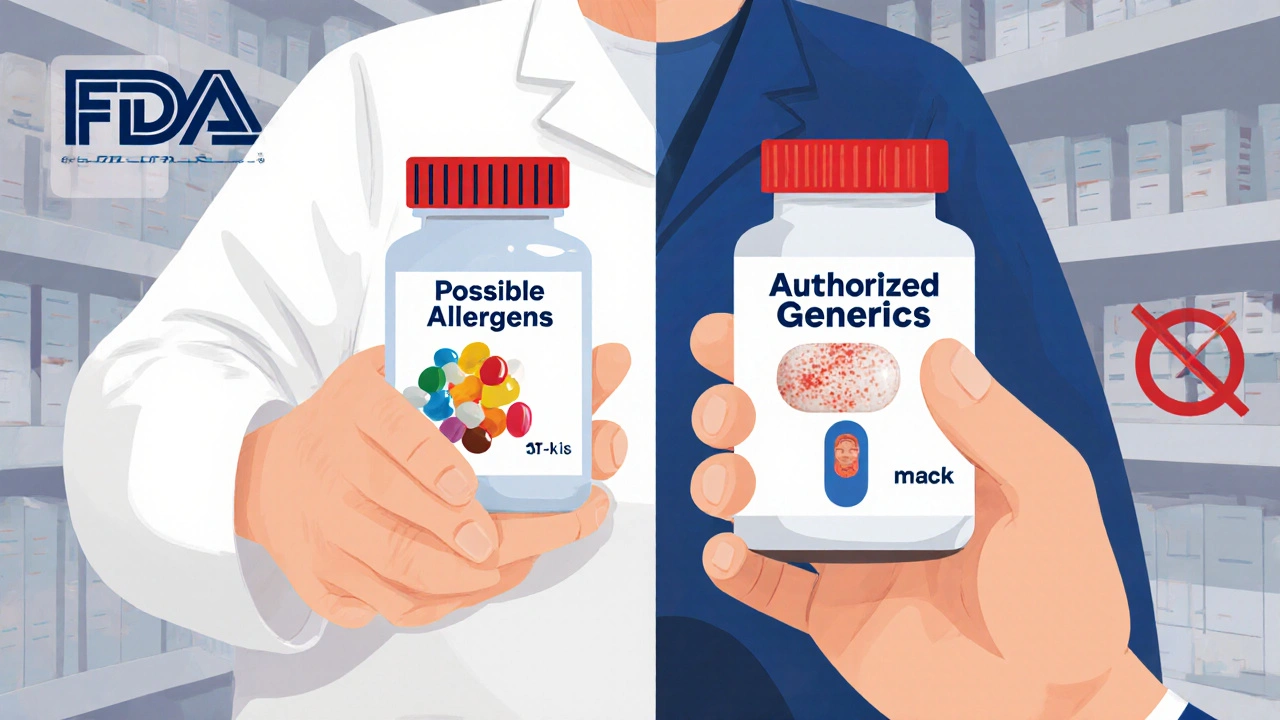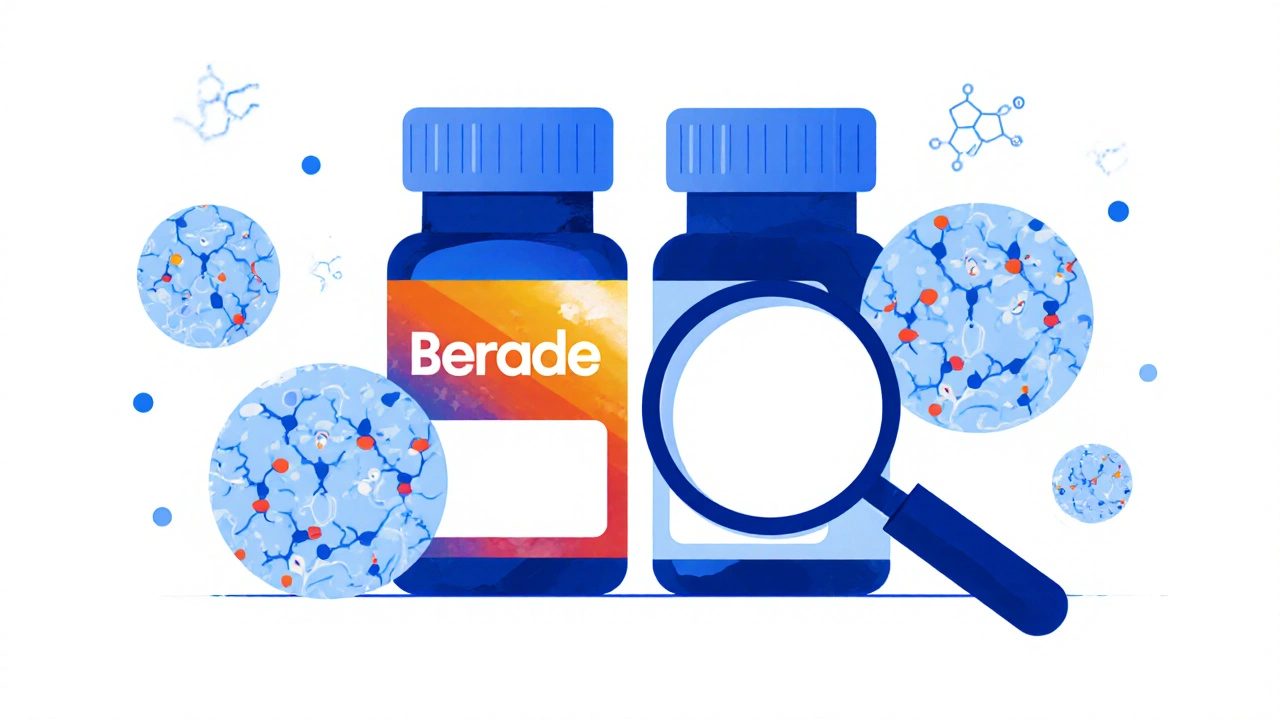When your pharmacist hands you a pill bottle with a different name than what your doctor prescribed, it’s natural to wonder: Is this the same thing? If you’ve been handed an authorized generic, the answer is yes-exactly the same. No guesswork. No hidden differences. Just the exact same drug, in the exact same packaging, with one small change: the brand name is gone.
What Exactly Is an Authorized Generic?
An authorized generic is not a copy. It’s not a look-alike. It’s not even a close match. It’s the exact same medication your doctor prescribed, made by the same company, in the same factory, using the same ingredients. The only difference? It doesn’t carry the brand name on the label.
Think of it like buying a soda. The brand version comes in a red can with a logo. The authorized generic? Same soda, same recipe, same factory-just in a plain white can. The FDA defines it clearly: "An approved brand name drug that is marketed without the brand name on its label. Other than the fact that it does not have the brand name on its label, it is the exact same drug product as the branded product."
How does this work? The original drug maker holds a New Drug Application (NDA) with the FDA. When they decide to release an authorized generic, they simply sell the exact same product under a different label-no new approval needed. That’s because it’s already been approved under the brand’s NDA. There’s no separate testing. No new clinical trials. Just the same pill, same capsule, same liquid, same inactive ingredients.
How Is This Different From Regular Generic Drugs?
This is where things get confusing. Most people think "generic" means "same as brand." But that’s not always true.
Regular generic drugs must prove they’re bioequivalent to the brand. That means the active ingredient must be absorbed into your body at a similar rate and amount. The FDA allows up to a 20% variation in how quickly it works-though in practice, most generics vary by only 4%. But here’s the catch: inactive ingredients can be completely different.
Those inactive ingredients? Things like dyes, fillers, preservatives, and coatings. They don’t treat your condition, but they can cause reactions. For people with allergies, sensitivities, or digestive issues, even small changes in these ingredients can lead to side effects-rashes, stomach upset, or even flare-ups of conditions like eczema or asthma.
Authorized generics don’t have this problem. They use the exact same inactive ingredients as the brand. If your body reacts to the brand, it will react the same way to the authorized generic. But if you’ve had issues with a regular generic, switching to the authorized version might solve the problem.
Why Do Brand Companies Sell Authorized Generics?
It sounds odd. Why would a company that spent millions developing a drug turn around and sell the same thing cheaper?
The answer is competition. When a brand drug’s patent expires, other companies can make their own generics. To protect their market share, the original manufacturer sometimes launches an authorized generic-often through a subsidiary or licensed partner. This lets them capture part of the generic market before competitors even get started.
It’s a smart business move, but it’s not always good for consumers. Because authorized generics are often priced higher than traditional generics-sometimes only 15-20% cheaper than the brand, instead of the 80-85% discount you’d expect. So while you’re getting the same drug, you might not be getting the best price.
Some experts call this a "pay-to-delay" tactic. The brand company doesn’t wait for competitors to drive prices down. Instead, they flood the market with their own cheaper version to keep others out. That’s why you might see an authorized generic available right after patent expiration, while other generics take months to arrive.

Are Authorized Generics Safer Than Regular Generics?
For most people, no difference. But for a small group, yes.
A 2018 study of over 5,000 patients found no meaningful difference in hospital visits, emergency room trips, or medication adherence between those taking brand drugs and those taking authorized generics. That’s reassuring. But when researchers looked at patients who switched from brand to regular generics, they found slightly higher rates of stopping the medication-likely due to side effects from different fillers or coatings.
People with allergies, autoimmune conditions, or chronic digestive disorders often report better outcomes with authorized generics. One patient on an allergy forum wrote: "I switched from the brand Xyzal to the authorized generic and noticed no difference. I’d tried the regular generic before and got a rash. This one? Perfect."
The American Academy of Allergy, Asthma & Immunology confirms: authorized generics are the safest choice for patients sensitive to inactive ingredients. If you’ve ever had an unexpected reaction to a generic, ask your pharmacist if an authorized version is available.
How to Spot an Authorized Generic
It’s not always obvious. The label won’t say "authorized generic." But there are clues.
- Check the manufacturer name. If it’s the same company that makes the brand drug (like Pfizer, AbbVie, or Johnson & Johnson), it’s likely an authorized generic.
- Look for the brand name in small print. Sometimes the original brand name appears on the packaging under "Manufactured for..."
- Ask your pharmacist. They can tell you if the generic you’re getting is authorized or traditional.
- Check the FDA’s list of authorized generics. It’s updated regularly and available online.
Don’t assume a generic is authorized just because it’s cheap. Some of the lowest-priced generics are traditional ones with different fillers. If you need the exact same formulation, don’t settle for guesswork.
Insurance and Cost: What You’ll Actually Pay
Insurance plans often treat authorized generics like regular generics. That means you’ll pay your generic copay-not the higher brand price. But here’s the twist: some insurers put authorized generics on a higher tier than traditional generics, even though they’re identical to the brand.
Why? Because the brand company sets the price. If the authorized generic costs $40 and the traditional generic costs $10, your insurer might still charge you $20 for the authorized version. They’re not penalizing you-they’re just following the manufacturer’s pricing.
GoodRx data from 2023 shows that while traditional generics are typically 80-85% cheaper than brand drugs, authorized generics are only 15-20% cheaper. So if your goal is to save money, the traditional generic is usually the better deal-unless you need the identical formulation.
Bottom line: Ask your pharmacist for the price of both. Sometimes the authorized generic is only $2 more than the regular one. If that’s the case, and you’ve had bad reactions before, it’s worth the extra few dollars.

What Pharmacists Want You to Know
Pharmacists see this confusion every day. About 30% of patients question why they’re getting a different-looking pill-even when it’s an authorized generic.
They’re not wrong to be confused. The system is messy. One pill can have three names: the brand name, the generic name, and the authorized generic name. And unless your doctor writes "dispense as written" (DAW), pharmacists are legally allowed to substitute generics without asking you.
If you want the authorized version, you need to ask for it. Say: "Can I get the authorized generic of this drug?" Or better yet: "I need the exact same formulation as the brand-no different fillers or dyes."
Most pharmacists will know what you mean. If they don’t, they can check with the wholesaler or call the manufacturer’s customer service line. It’s your right to know what you’re getting.
When to Choose an Authorized Generic
You should consider an authorized generic if:
- You’ve had side effects from a regular generic (rash, nausea, headaches)
- You have allergies to dyes, gluten, or other inactive ingredients
- You’re on a chronic medication and want maximum consistency
- You’ve had trouble staying on your medication because of discomfort
You don’t need an authorized generic if:
- You’ve never had a reaction to generics
- Your main goal is saving money
- You’re taking a short-term medication
For most people, traditional generics are safe, effective, and affordable. But for the 5-10% of patients who are sensitive to inactive ingredients, authorized generics aren’t just a better option-they’re the only safe one.
What’s Next for Authorized Generics?
The FDA is looking at ways to make authorized generics more transparent. They’re considering adding pricing data to the Orange Book-the official list of approved drugs-so patients and doctors can see exactly how much each version costs.
Legislators are also paying attention. The Affordable Prescriptions for Patients Act of 2023 includes provisions to stop brand companies from using authorized generics to block competition. If passed, it could lead to more traditional generics entering the market faster.
For now, authorized generics remain a quiet but powerful tool in the drug supply chain. They’re not a loophole. They’re not a trick. They’re a legitimate, FDA-approved way to get the exact same medication at a lower price-sometimes.
The key is knowing the difference. And asking the right questions.
Are authorized generics the same as brand drugs?
Yes. Authorized generics are chemically and physically identical to their brand-name counterparts. They contain the same active ingredients, the same inactive ingredients, the same dosage form, and are made in the same facility. The only difference is the label doesn’t carry the brand name.
Why are authorized generics sometimes more expensive than regular generics?
Because they’re sold by the original brand manufacturer or its affiliate. They set the price, and since they’re not competing with multiple generic makers, they often price them closer to the brand-sometimes only 15-20% cheaper. Regular generics, made by competing companies, drive prices down to 80-85% less than the brand.
Can I ask my pharmacist for an authorized generic?
Absolutely. You have the right to request it. Just say: "Can I get the authorized generic of this drug?" or "I need the exact same formulation as the brand-no different fillers." Pharmacists are trained to handle these requests and can check availability with their supplier.
Do authorized generics show up in the FDA’s Orange Book?
No. Authorized generics are not listed in the Orange Book because they’re sold under the brand’s original New Drug Application (NDA), not a separate generic approval (ANDA). Traditional generics are listed there with therapeutic equivalence ratings. To find authorized generics, you need to check the FDA’s separate authorized generic list.
Are authorized generics better for people with allergies?
Yes. Because they use the exact same inactive ingredients as the brand, they’re the safest option for people with sensitivities to dyes, fillers, or preservatives. Regular generics may use different coatings or binders that can trigger reactions. If you’ve had issues with generics before, an authorized version is worth trying.








12 Comments